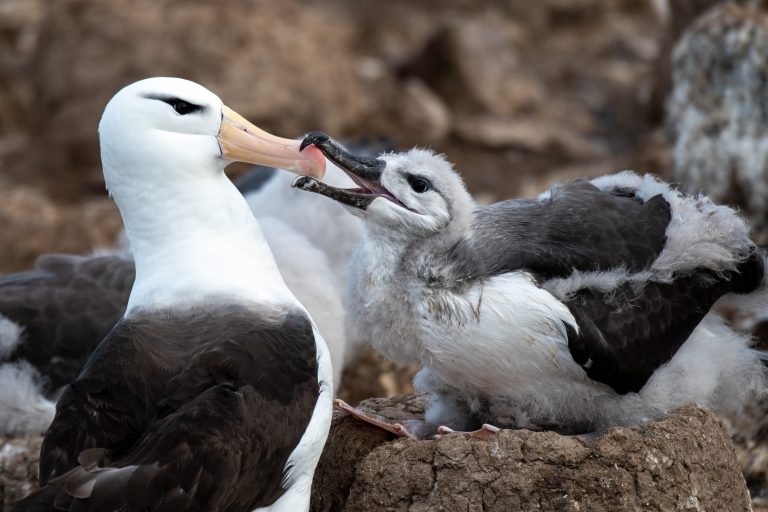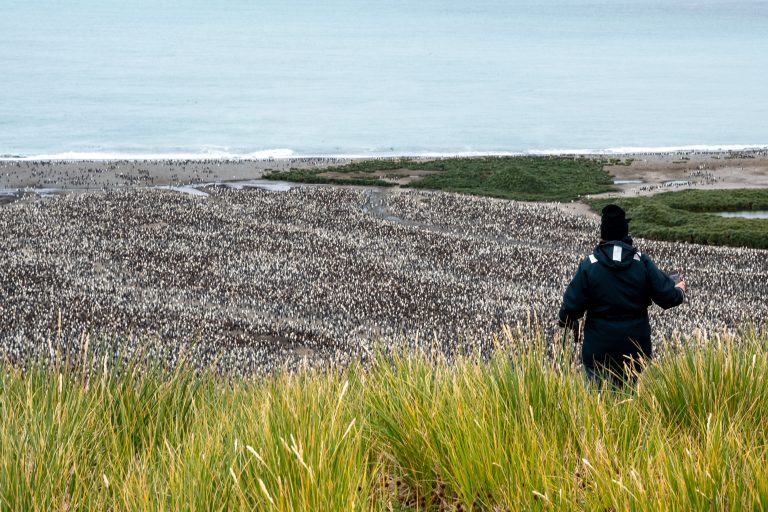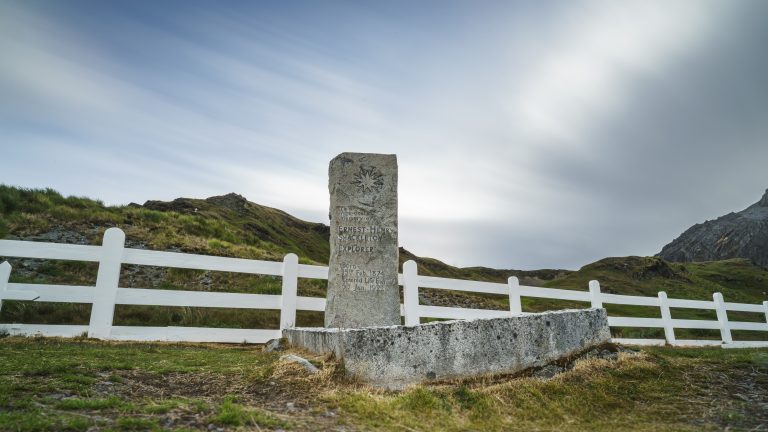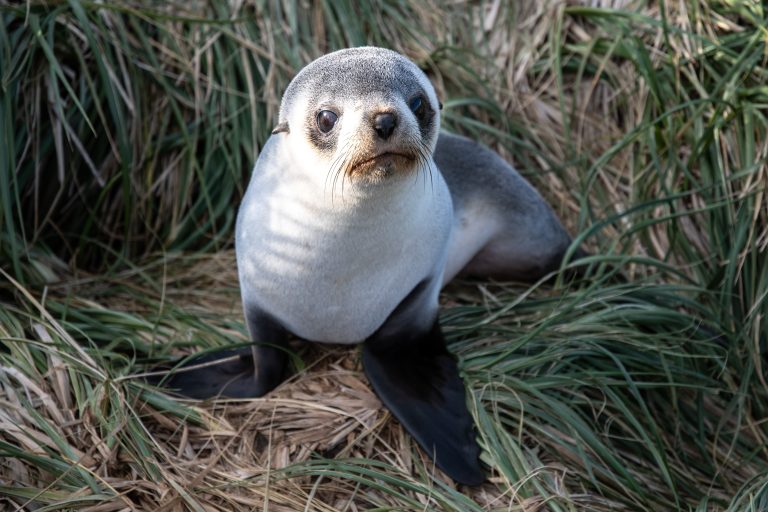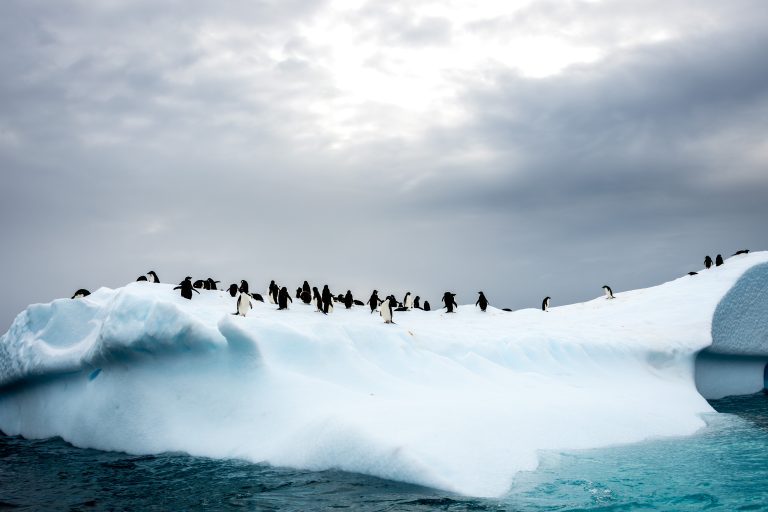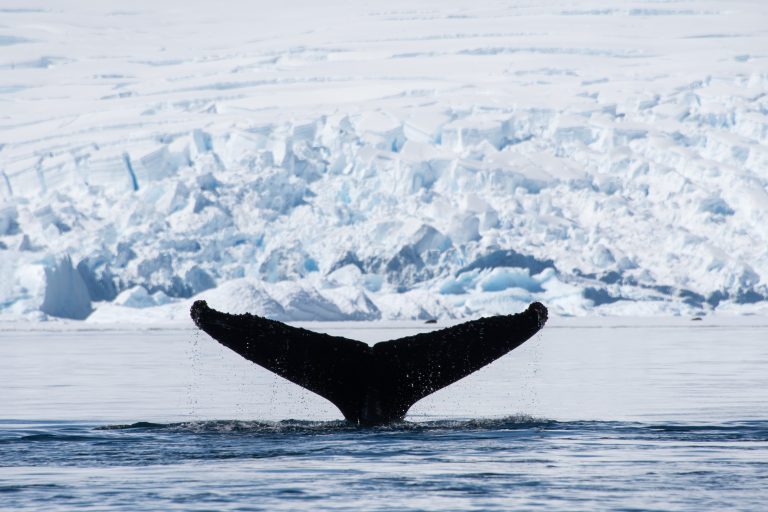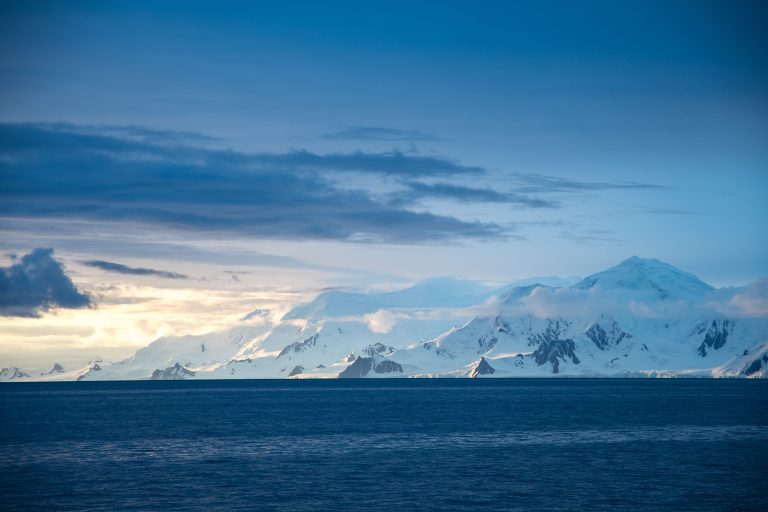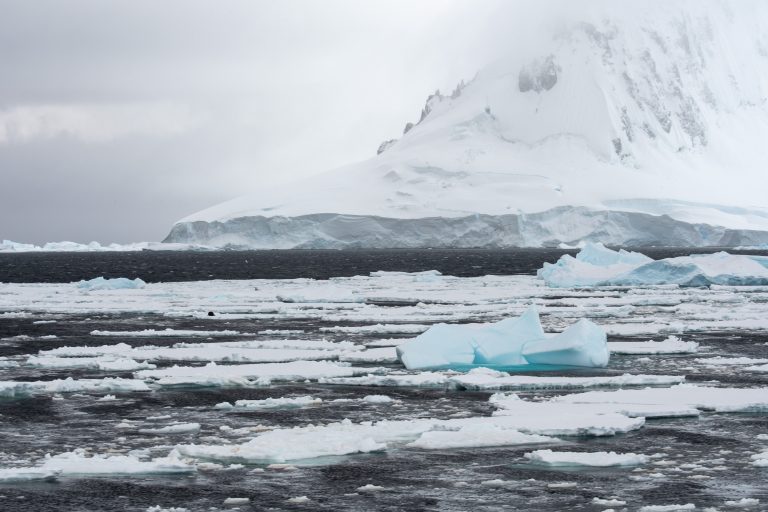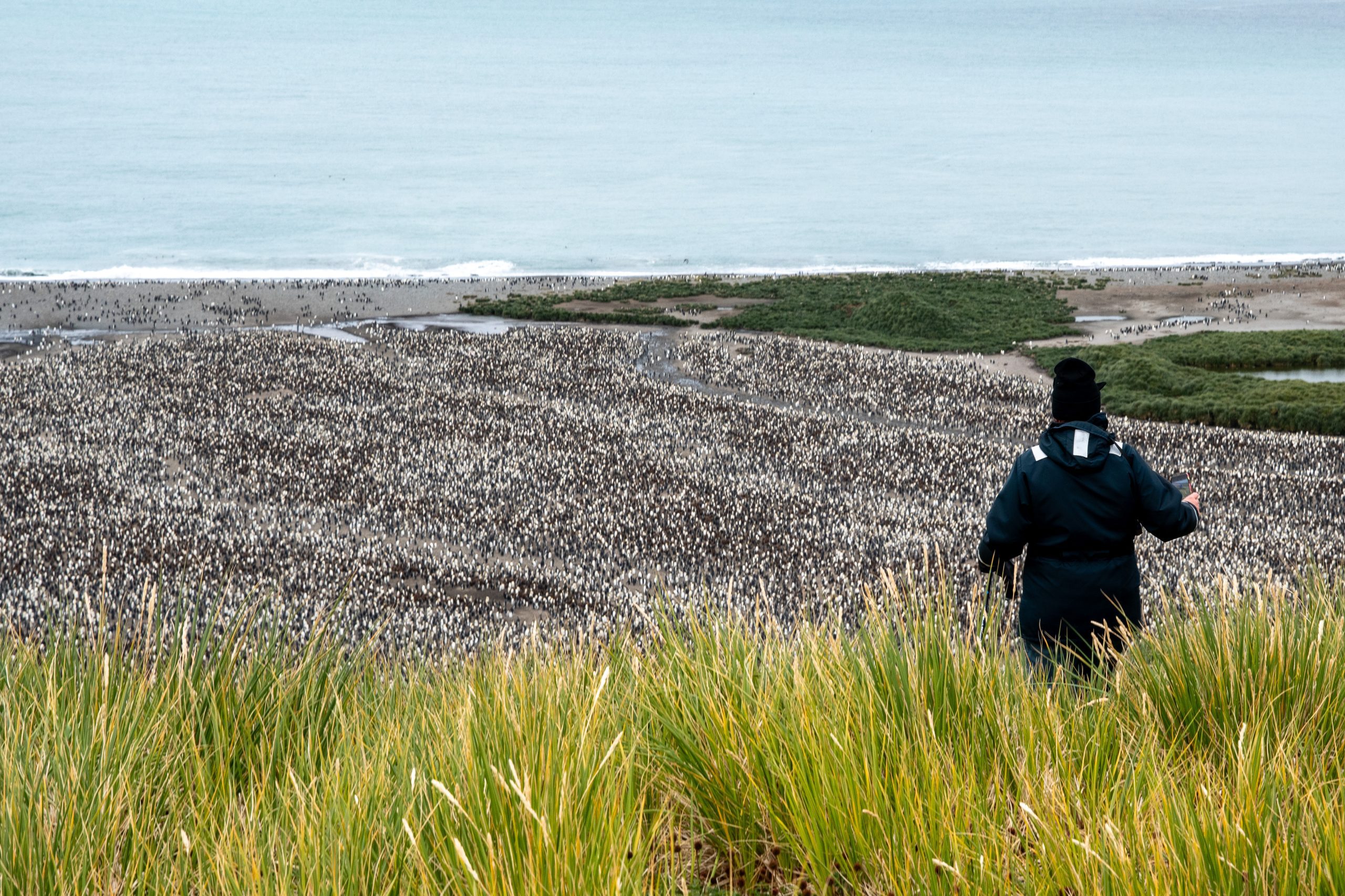
Falkland Islands - South Georgia - Elephant Island - Antarctica - Polar Circle - 23 Days
Aboard Hondius – 170 passengers
This Falkland Islands, South Georgia, and Antarctic Peninsula cruise is an animal-lover’s dream come true. The expedition explores one of the last untamed areas on Earth – a land of ruggedly beautiful landscapes and amazingly varied wildlife. This extended voyage will sail further south in Antarctica to cross the Antarctic Circle (conditions permitting).
Tour Dates
-
Feb 16 - Mar 10, 2026 (23 days)
-
Feb 13 - Mar 7, 2027 (23 days)
Itinerary
Day 1: Embarkation from Ushuaia, Argentina
Your voyage begins where the world drops off. Ushuaia, Argentina, reputed to be the southernmost city on the planet, is located on the far southern tip of South America. Starting in the afternoon, you embark from this small resort town on Tierra del Fuego, nicknamed “The End of the World,” and sail the mountain-fringed Beagle Channel for the remainder of the evening.
Day 2: At Sea
Several species of albatross follow the vessel into the westerlies, along with storm petrels, shearwaters, and diving petrels.
Day 3: Falklands
The Falkland Islands offer an abundance of wildlife that is easily approachable, though caution is always advised. These islands are largely unknown gems, the site of a 1982 war between the UK and Argentina. Not only do various species of bird live here, but chances are great you’ll see both Peale’s dolphins and Commerson’s dolphins in the surrounding waters.
During this segment of the voyage, you may visit the following sites:
Westpoint Island – This beautiful island hosts a bounty of birdlife, from shore birds near the landing site to black-browed albatrosses on the nest. Among them is a rookery of rockhopper penguins who have to undertake an incredible climb from the sea to get to their nests among the albatrosses.
Saunders Island – On Saunders Island you can see the black-browed albatross and its sometimes-clumsy landings, along with breeding imperial shags and rockhopper penguins. King penguins, Magellanic penguins, and gentoos are also found here.
Day 4: Stanley, Falklands
The capital of the Falklands and center of its culture, Stanley is a great place to enjoy some Victorian-era charm: colorful houses, well-tended gardens, and English-style pubs abound here. You can also see several century-old clipper ships nearby, silent witnesses to the hardships of 19th century sailors. The local museum is also worth a visit and offers free admission, covering the early days of settlement up to the Falklands War. Approximately 2,500 people currently live in Stanley.
Day 5 – 6: At Sea
En route to South Georgia, you now cross the Antarctic Convergence. The temperature cools considerably within the space of a few hours, and nutritious water rises to the surface of the sea due to colliding water columns. This phenomenon attracts a multitude of seabirds near the ship, including several species of albatross, shearwaters, petrels, prions, and skuas.
Day 7 – 10: South Georgia
Today you arrive at the first South Georgia activity site. Please keep in mind that weather conditions in this area can be challenging, largely dictating the program. Over the next several days, you have a chance to visit the following sites:
Fortuna Bay – A beautiful outwash plain from Fortuna Glacier is home to a large number of king penguins and seals. Here you may also have the chance to follow the final leg of Shackleton’s route to the abandoned whaling village of Stromness. This path cuts across the mountain pass beyond Shackleton’s Waterfall, and as the terrain is partly swampy, be prepared to cross a few small streams.
Salisbury Plain, St. Andrews Bay, Gold Harbour– These sites not only house the three largest king penguin colonies in South Georgia, they’re also three of the world’s largest breeding beaches for Antarctic fur seals. Literally millions of these animals breed on South Georgia during December and January, but only during the mid-season do they peak in their breeding cycle. You may also see some young adult elephant seals as well as this seasons “weaners” young elephant seals that have been left to fend for themselves. Watch your step and stay calm when walking the beaches during this time.
Grytviken– In this abandoned whaling station, king penguins walk the streets and elephant seals lie around like they own the place – because they basically do. Here you might be able to see the fascinating South Georgia Museum as well as Shackleton’s grave.
In the afternoon of Day 10 and depending on the conditions, we will start sailing southwards in the direction of the South Orkney Islands.
Day 11: At Sea
There may be sea ice on this route, and at the edge of the ice some south polar skuas and snow petrels could join the other seabirds trailing the vessel south.
Day 12: The Scenic Vistas of South Orkney
Conditions permitting, you might visit Orcadas Base today. Orcadas is an Argentine research station on Laurie Island in the South Orkney archipelago. The personnel will happily show you their facility, where you can enjoy expansive views of the surrounding glaciers. If a visit isn’t possible, however, we may instead land in Coronation Island’s Shingle Cove.
Day 13: Elephant Island
You‘ve now completed roughly the same route (albeit in the opposite direction) as Sir Ernest Shackleton did using only a small life boat, the James Caird, in spring of 1916. Watching Elephant Island materialize on the horizon after crossing all that water, it’s hard not to marvel at how he and his five-man crew accomplished that feat. The purpose of Shackleton’s crossing was to rescue 22 shipwrecked members of his Imperial Trans-Antarctic Expedition, also known as the Endurance Expedition, who were stranded on Elephant Island. For four and a half months, Shackleton undertook this legendary rescue. Conditions on Elephant Island are severe. The coastline is mostly made up of vertical rock and ice cliffs highly exposed to the elements. If possible you will take the Zodiacs to Point Wild, where the marooned members of Shackleton’s expedition miraculously managed to survive.
Day 14: Along the Antarctic Peninsula
If ice permits, you sail into the Antarctic Sound at the northwestern edge of the Weddell Sea. Here colossal tabular icebergs herald your arrival to the eastern edges of the Antarctic Peninsula. Brown Bluff is a potential location for a landing, where you may get the chance to set foot on the continent.
Day 15: South Shetland Islands
The volcanic islands of the South Shetlands are windswept and often cloaked in mist, but they do offer subtle pleasures: There’s a wide variety of flora (mosses, lichens, flowering grasses) and no small amount of fauna (gentoo penguins, chinstrap penguins, southern giant petrels). In Deception Island, the ship plunges through Neptune’s Bellows and into the flooded caldera. Here you find an abandoned whaling station, and thousands of cape petrels – along with kelp gulls, brown and south polar skuas, and Antarctic terns. A good hike is a possibility in this fascinating and desolate volcanic landscape.
Day 16 – 20: Onward into Antarctica
Gray stone peaks sketched with snow, towers of broken blue-white ice, and unique polar wildlife below and above welcome you into the otherworldly expanse of Antarctica. You enter the area around Gerlache Strait, venturing into one of the most beautiful settings Antarctica has to offer.
Sites you may visit here include:
Neko Harbour– An epic landscape of mammoth glaciers and endless wind-carved snow, Neko Harbour offers opportunities for a Zodiac cruise and landing that afford the closest views of the surrounding alpine peaks.
Paradise Bay– You may be able to take a Zodiac cruise in these sprawling, ice-flecked waters, where there’s a good chance you’ll encounter humpback and minke whales.
The aim is then to head south. If conditions allow, sites you can visit ‘over’ the polar circle include:
Crystal Sound– Your journey takes you south along the Argentine Islands to this ice-packed body of water, and from here across the Polar Circle in the morning.
Detaille Island – You may make a landing at an abandoned British research station here, taking in the island’s lofty mountains and imposing glaciers.
Pourquoi Pas Island – You might circumnavigate this island, named after the ship of the famous French explorer Jean-Baptiste Charcot. This location is known for its tight fjords and lofty, glacier-crowded mountains.
Horseshoe Island – This is the location of the former British Base Y, a remnant of the 1950s that is now unmanned though still equipped with almost all the technology it had while in service.
As with all of our Antarctic trips, conditions on the Drake Passage determine the exact time of departure.
Day 21-22: Drake Passage
Your return voyage is far from lonely. While crossing the Drake, you’re again greeted by the vast array of seabirds remembered from the passage south. But they seem a little more familiar to you now, and you to them.
Day 23: Disembarkation in Ushuaia
Every adventure, no matter how grand, must eventually come to an end. It’s now time to disembark in Ushuaia, but with memories that will accompany you wherever your next adventure lies.
PLEASE NOTE: All itineraries are for guidance only. Programs may vary depending on ice, weather, and wildlife conditions. Landings are subject to site availabilities, permissions, and environmental concerns per IAATO regulations. Official sailing plans and landing slots are scheduled with IAATO prior to the start of the season, but the expedition leader determines the final plan. Flexibility is paramount for expedition cruises. The average cruising speed for our vessel is 10.5 knots.
Route Map

Trips and Rates
Please note, rates are Per Person in USD
Falkland Islands – South Georgia – Elephant Island – Antarctica – Polar Circle
Feb 13 - Mar 7, 2027 (23 days)Falkland Islands – South Georgia – Elephant Island – Antarctica – Polar Circle
Feb 16 - Mar 10, 2026 (23 days)Single Travelers:
- Can book into a share cabin in Quad – Twin Deluxe
- Can book a twin cabin at solo occupancy at 1.7x the per person share price
Adventure Options:
- Kayaking (full program, multiple paddles): $450/person for 2024 season and $470/person for 2025 season – requires experience
Single Travelers:
- Can book into a share cabin in Quad – Twin Deluxe
- Can book a twin cabin at solo occupancy at 1.7x the per person share price
Adventure Options:
- Kayaking (full program, multiple paddles): $560/person – requires experience
- On Basecamp departures all activities are free
Availability & prices are subject to change at anytime. Please contact us for the real time availability & prices.
Cabin Descriptions
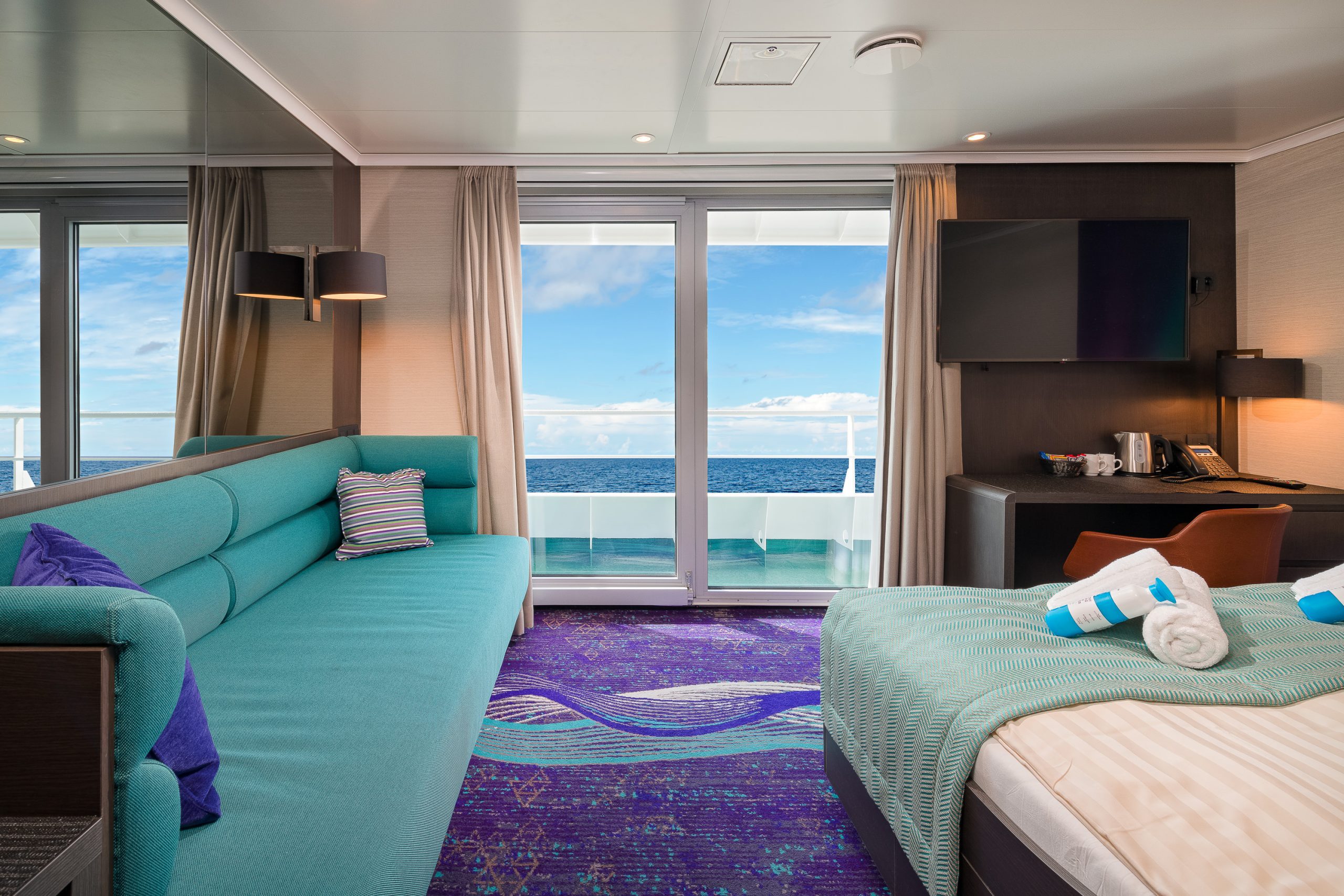
Grand Suite with private balcony
Located on deck 7, the six Grand Suites are the only cabins on the ship with a private balcony. Features: 1 double window, 1 double bed, Sofa, Private balcony, Private shower & toilet, Flatscreen TV, Desk & chair, Telephone and WiFi (supplemented), Refrigerator, Coffee & tea maker, Bathrobe, Hair dryer, Cabinet, Safe deposit box & Wardrobe.
291 square feet / 27 square meters.
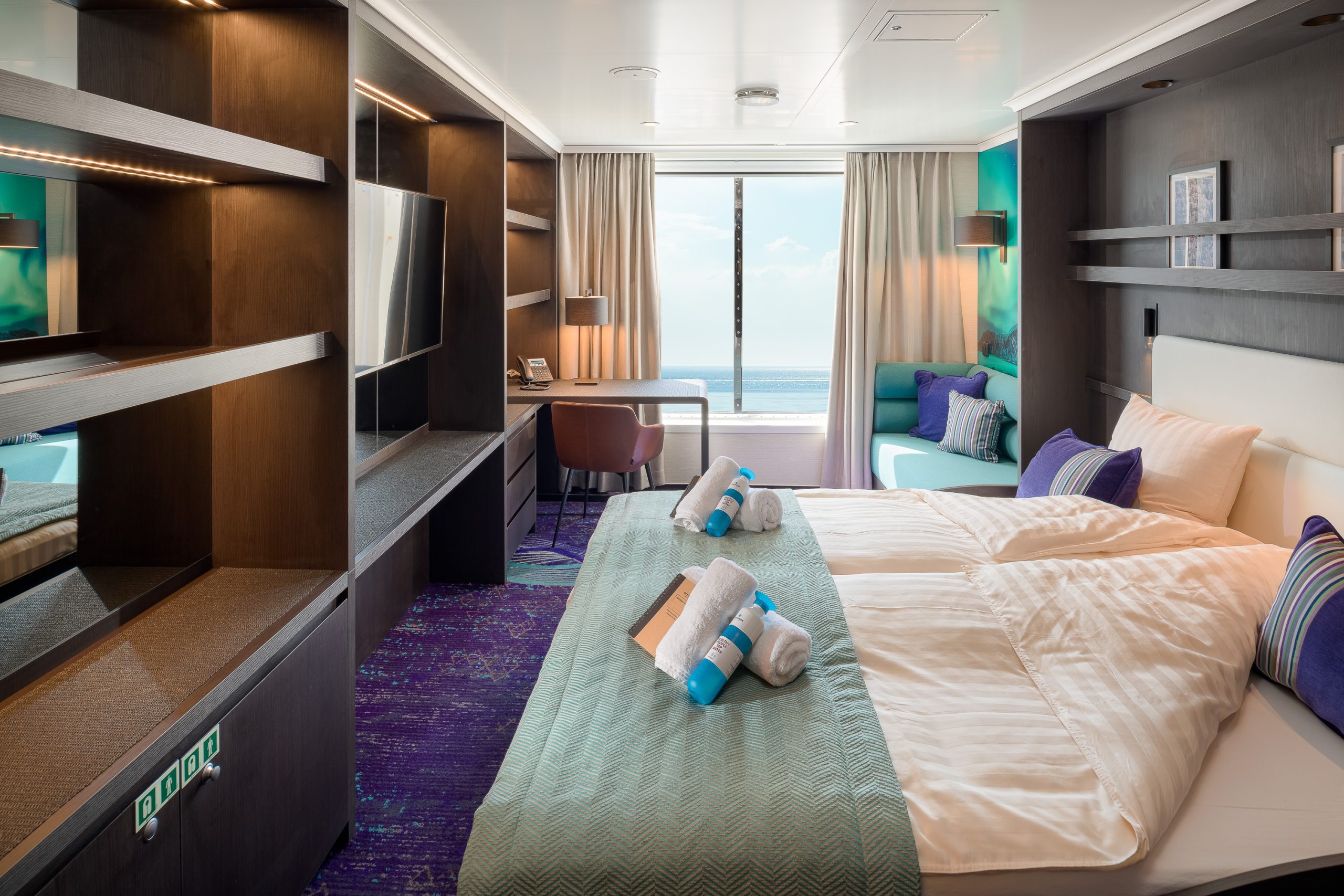
Junior Suite
The eight Junior Suites are on deck 7. Features: 1 double window, 1 double bed, Private shower & toilet, Flatscreen TV, Desk & chair, Telephone and WiFi (supplemented), Refrigerator, Coffee & tea maker, Bathrobe, Hair dryer, Cabinet, Safe deposit box & Wardrobe.
205 to 215 square feet / 19 to 20 square meters
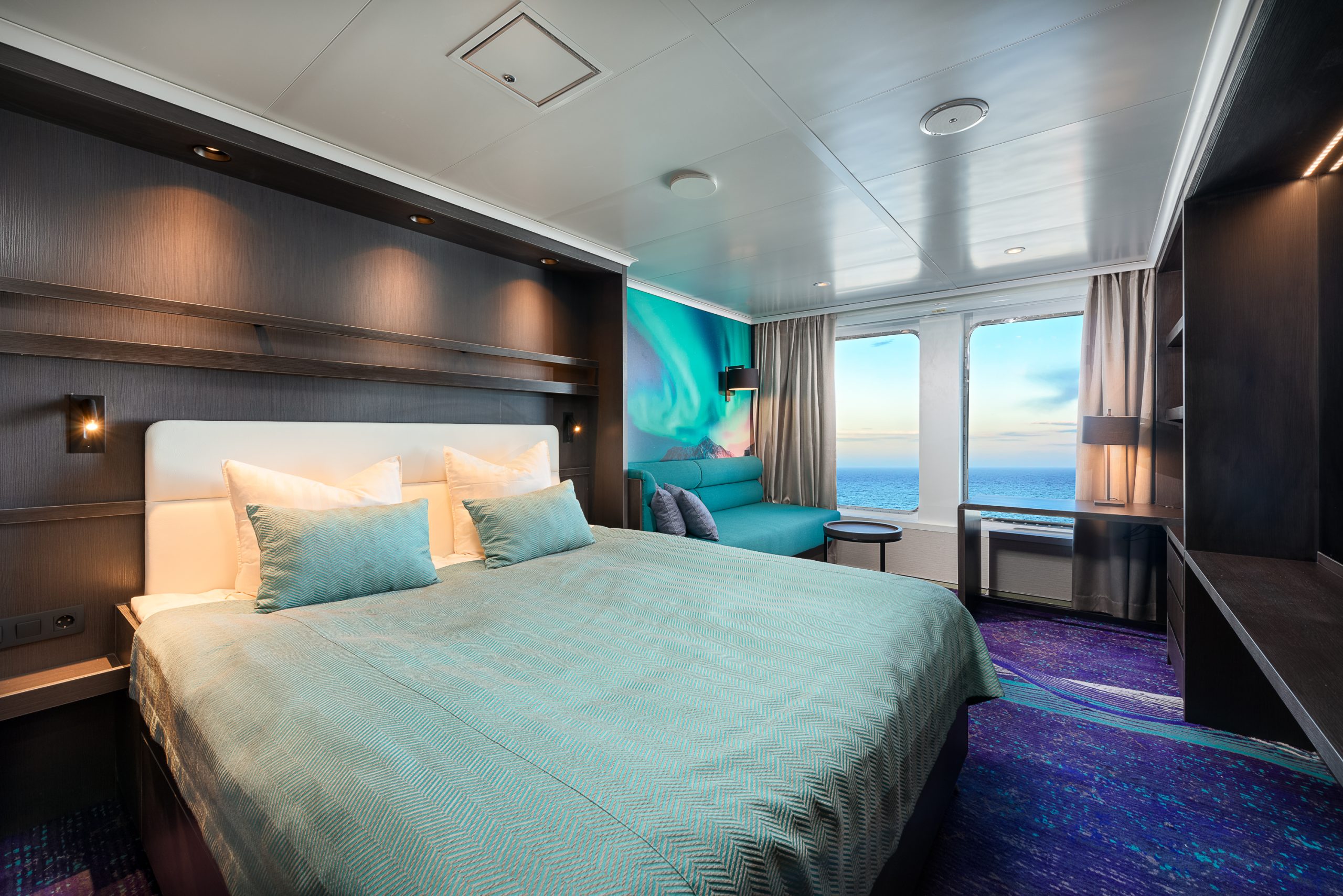
Superior
Eight Superior cabins on deck 6. Features: 2 windows, 1 double bed, Sofa, Private shower & toilet, Flatscreen TV, Desk & chair, Telephone and WiFi (supplemented), Refrigerator, Coffee & tea maker, Bathrobe, Hair dryer, Cabinet, Safe deposit box & Wardrobe.
215 to 226 square feet / 20 to 21 square meters
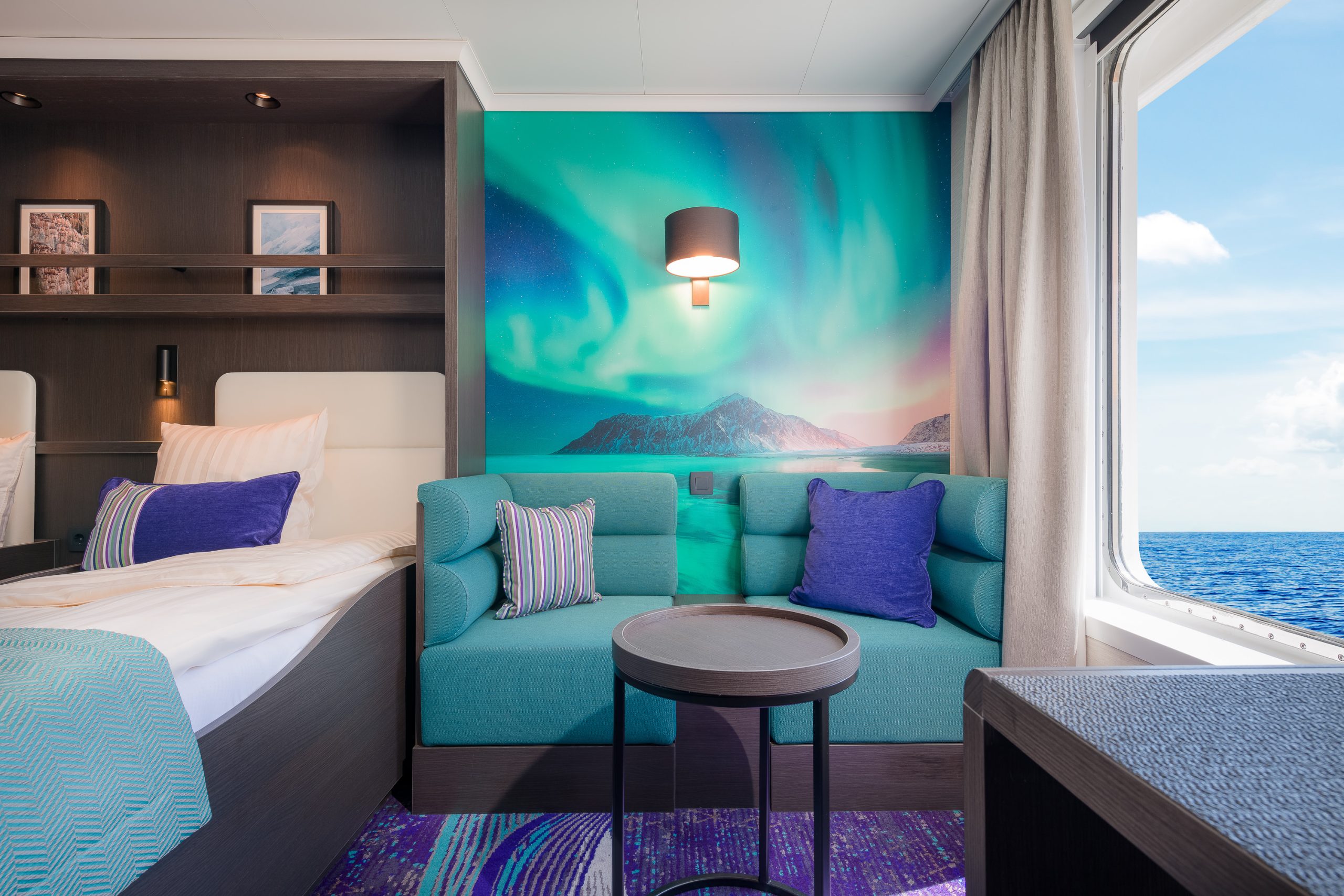
Twin Deluxe
Eleven Twin Deluxe cabins on deck 6. Features: 2 windows, 2 single beds, Sofa, Private shower & toilet, Flatscreen TV, Desk & chair, Telephone and WiFi (supplemented), Refrigerator, Coffee & tea maker, Bathrobe, Hair dryer, Cabinet, Safe deposit box & Wardrobe.
205 to 226 square feet / 19 to 21 square meters
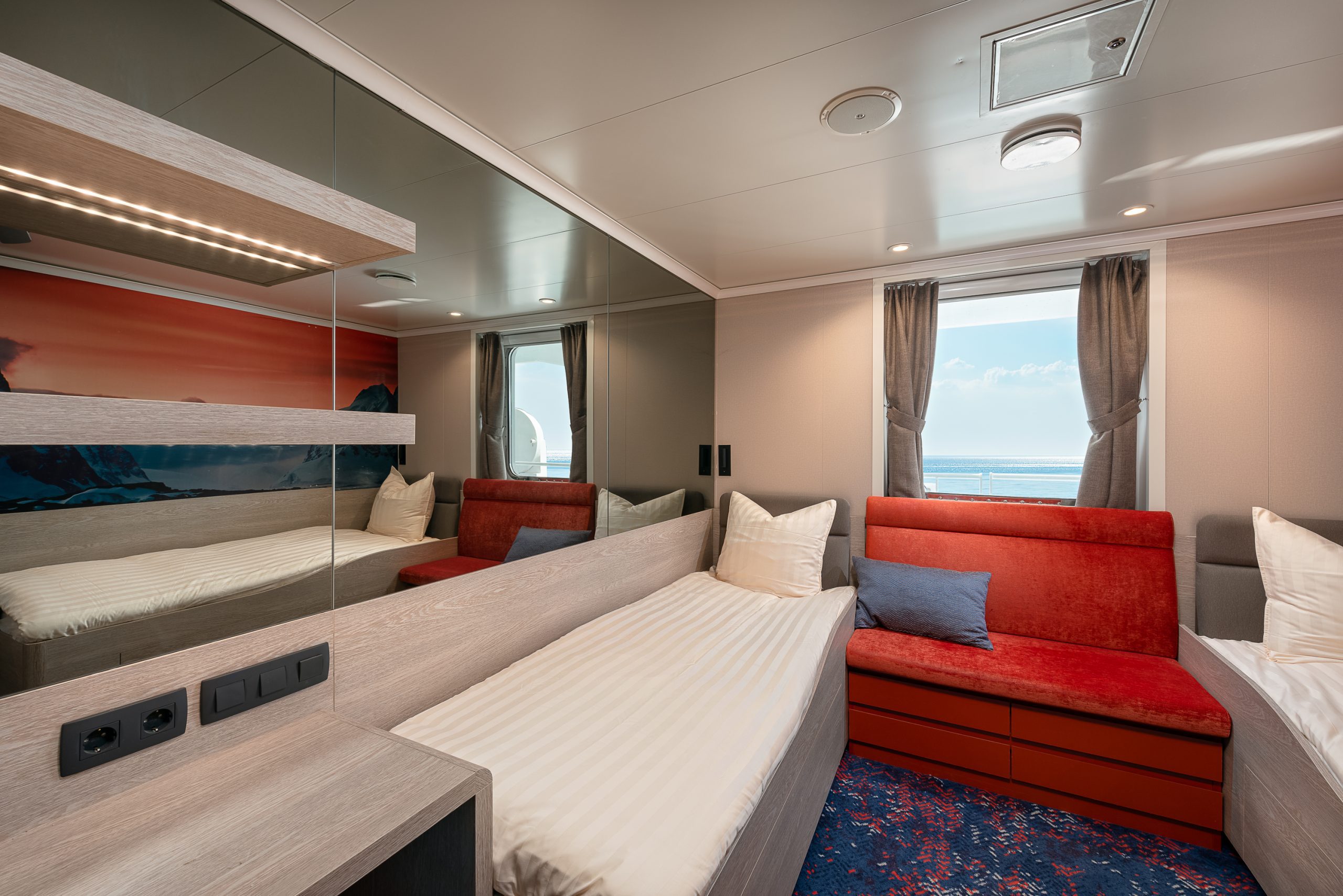
Twin Window
The fourteen Twin Windows are the only cabins on deck 4. Features: 1 window, 2 single beds, Small sofa, Private shower & toilet, Flatscreen TV, Desk & chair, Telephone and WiFi (supplemented), Hair dryer, Cabinet, Safe deposit box & Wardrobe. Please be aware that the view from some windows might be partially obstructed due to the design requirements of the ship. Please note that all cabins will not necessarily have the same layout and surface area, nor will they be identical to the examples used in the photos
129 to 151 square feet / 12 to 14 square meters
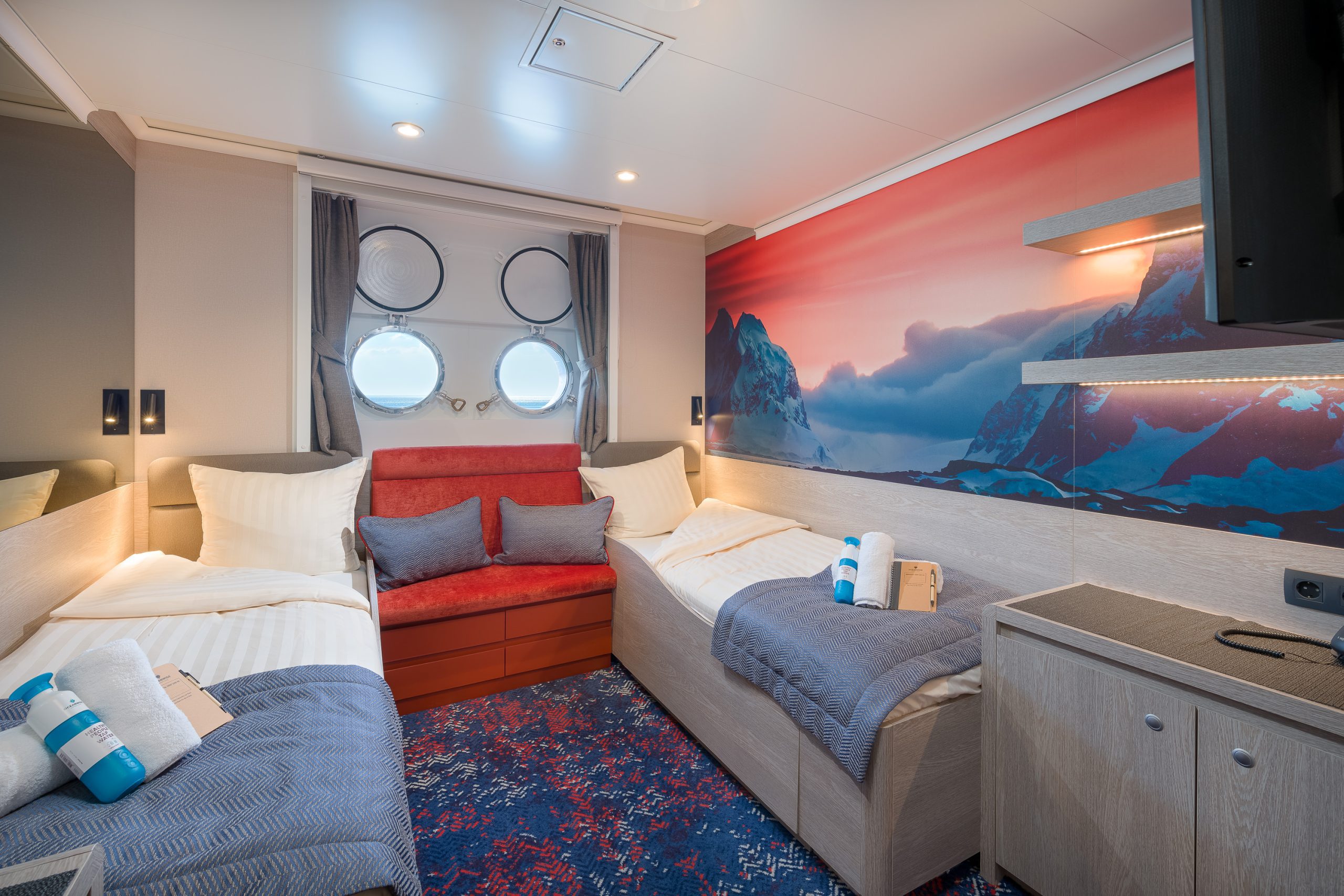
Twin Porthole
The twenty seven Twin Porthole cabins are on deck 3. Features: 2 portholes, 2 single beds, Small sofa, Private shower & toilet, Flatscreen TV, Desk & chair, Telephone and WiFi (supplemented), Hair dryer, Cabinet, Safe deposit box & Wardrobe. Please note that all cabins will not necessarily have the same layout and surface area, nor will they be identical to the examples used in the photos
143 to 172 square feet / 13 to 16 square meters
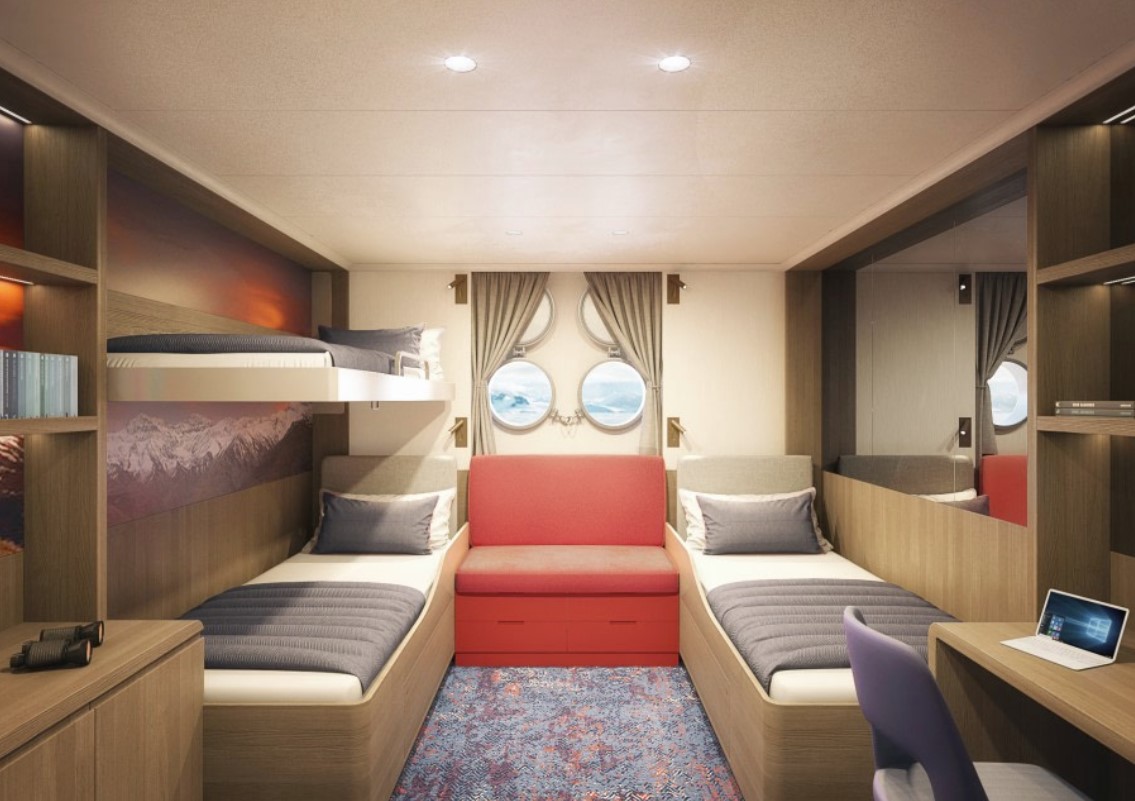
Triple Porthole
Two Triple cabins on deck 3. Features: 2 portholes, 1 upper & 2 lower berths, Small sofa, Private shower & toilet, Flatscreen TV, Desk & chair, Telephone and WiFi (supplemented), Hair dryer, Cabinet, Safe deposit box & Wardrobe.
172 square feet / 16 square meters
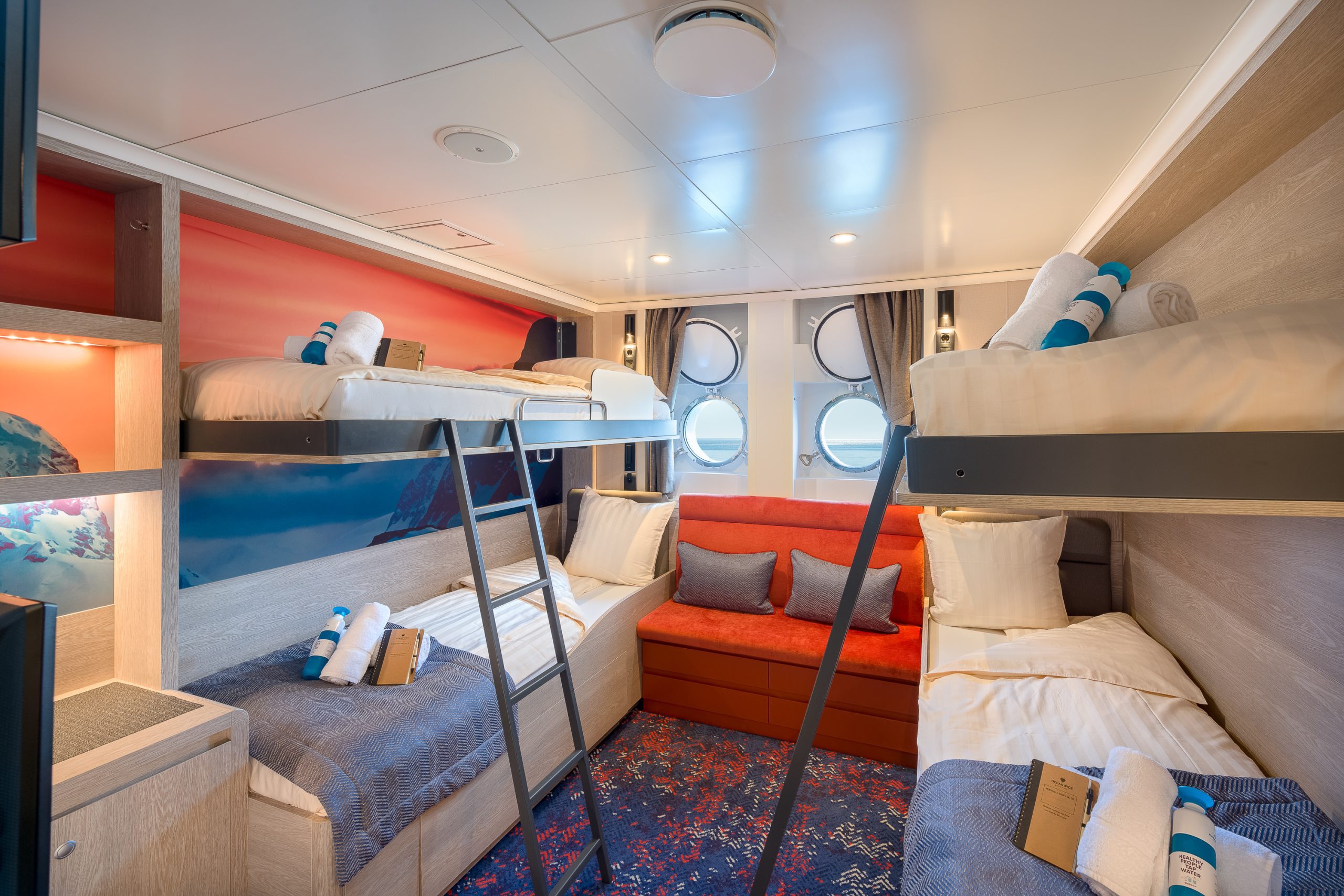
Quadruple Porthole
Four Quad cabins located on deck 3. Features: 2 portholes, 2 upper & 2 lower berths, Small sofa, Private shower & toilet, Flatscreen TV, Desk & chair, Telephone and WiFi (supplemented), Hair dryer, Cabinet, Safe deposit box & Wardrobe.
165 to 172 square feet / 15.3 to 16 square meters
Deck Plan
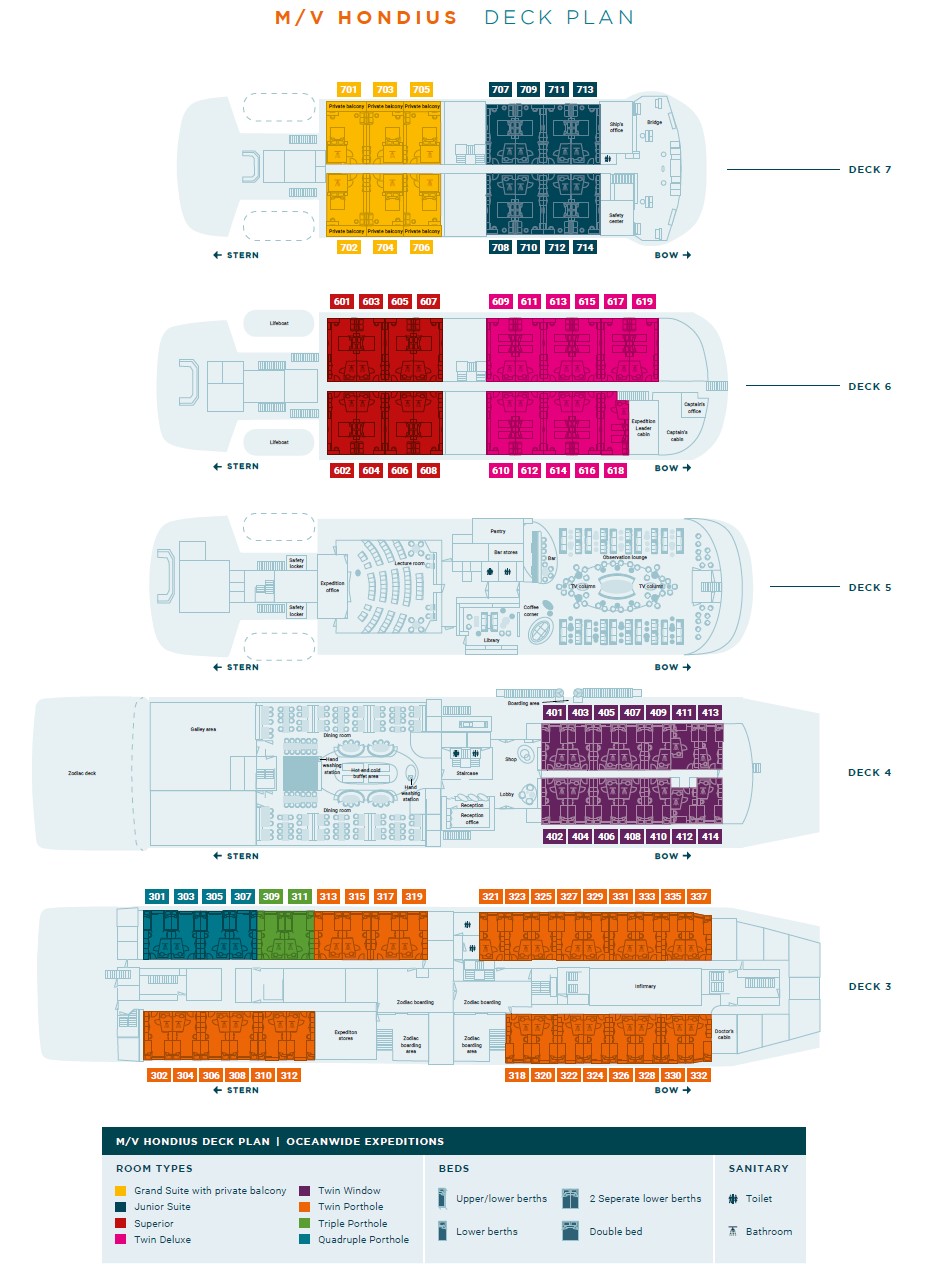
Inclusions & Exclusions
Inclusions:
- Voyage aboard the indicated vessel as indicated in the itinerary
- All meals throughout the voyage aboard the ship including snacks, coffee and tea.
- All shore excursions and activities throughout the voyage by Zodiac.
- Program of lectures by noted naturalists and leadership by experienced expedition staff.
- Free use of rubber boots and snowshoes.
- Luggage transfer from pick-up point to the vessel on the day of embarkation, in Ushuaia.
- Pre-scheduled group transfer from the vessel to the airport in Ushuaia (directly after disembarkation).
- All miscellaneous service taxes and port charges throughout the programme.
- Comprehensive pre-departure material.
Exclusions:
- Any airfare, whether on scheduled or charter flights
- Pre- and post- land arrangements.
- Passport and visa expenses.
- Government arrival and departure taxes.
- Meals ashore.
- Baggage, cancellation and personal insurance (which is strongly recommended).
- Excess baggage charges and all items of a personal nature such as laundry, bar, beverage charges and telecommunication charges.
- The customary gratuity at the end of the voyages for stewards and other service personnel aboard (guidelines will be provided).
